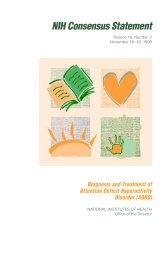Celiac Disease - NIH Consensus Development Program - National ...
Celiac Disease - NIH Consensus Development Program - National ...
Celiac Disease - NIH Consensus Development Program - National ...
You also want an ePaper? Increase the reach of your titles
YUMPU automatically turns print PDFs into web optimized ePapers that Google loves.
adhered to the GFD after more than 1 year. (15) Reasons for transgressions included poorpalatability of GF foods, absence of symptoms after “cheating,” high cost of the GFD, and thenonspecified presence of gluten or erroneous affirmation of gluten absence in foods andmedications. Only 56–83 percent of teenagers with CD are considered to be on a strict GFD, (16–18)while the reported adult compliance has varied between 17 percent and 45 percent. (19,20) Patientsdiagnosed with CD via serologic mass screening in Italy showed more EMA+ and lowercompliance in comparison to age-matched patients diagnosed with “classic” symptoms duringchildhood. (21) Less than one-fourth of these patients followed a strict GFD, while 23 percent hadreturned to a normal diet after 5 years.Women with CD perceive a greater burden of illness, and express less satisfaction withthe outcome of treatment. Women are also more concerned about needing more knowledge aboutCD, interference with socializing, and the possibility that their children could get CD. Both sexesexpress bitterness over not being diagnosed earlier, believing that this could have led to betteroutcomes. (22) For many persons with CD, the major complaints are general poor health, fatigue,and a feeling of decreased well-being. (23) These symptoms may improve once the patient starts aGFD. (24) Corrao et al. published that the overall mortality in adult CD patients was double that ofthe general population, and that a delay in diagnosis, poor adherence to treatment, and severity ofsymptoms at presentation unfavorably affected patients’ outlook. (25) The GFD has been shown toimprove the quality of life even in patients with symptomless CD. (26) Patients at the time of CDdiagnosis express fear, anger, anxiety, and sadness. Anger can worsen the patient–clinicianrelationship and has been inversely correlated with dietary compliance. (27)In the United States, food labeling does not clearly state whether gluten is present ina product. The American <strong>Celiac</strong> Task Force made its debut in March 2003(http://capwiz.com/celiac/home/) to advocate for changing the food labeling law. In March 2004,the Senate passed the “Food Allergen Labeling and Consumer Protection Act.” Similarlegislation was introduced into the House in December 2003. These bills require foodmanufacturers to clearly state if a product contains the top eight food allergens (including wheat)and calls for the Food and Drug Administration to issue rules defining and permitting the term“gluten-free” on food labeling.The management of CD primarily consists of monitoring for compliance andcomplications. The patient should follow up with the gastroenterologist who performed thebiopsy once the results confirm CD, and be referred to a dietitian knowledgeable about the GFD(figure 1). Patients should be encouraged to join local chapters of national support organizations,which can aid in finding local resources such as supermarkets, food manufacturers, literature,and restaurants that are familiar with the GFD. Patients should be screened for nutritionaldeficiencies that can accompany this malabsorptive disorder and monitored for complications,including osteoporosis, neurologic complaints, other autoimmune diseases, refractory sprue,ulcerative enteritis, T-cell lymphoma, and other GI cancers. Numerous studies have documentedlow bone density in children and adults at the time of initial diagnosis of CD, which improveswith the GFD. (28–31) Children should be examined for protein–calorie malnutrition, linear growthfailure, and delayed puberty. First- and second-degree relatives should be offered screening forCD with serum antibodies.104







